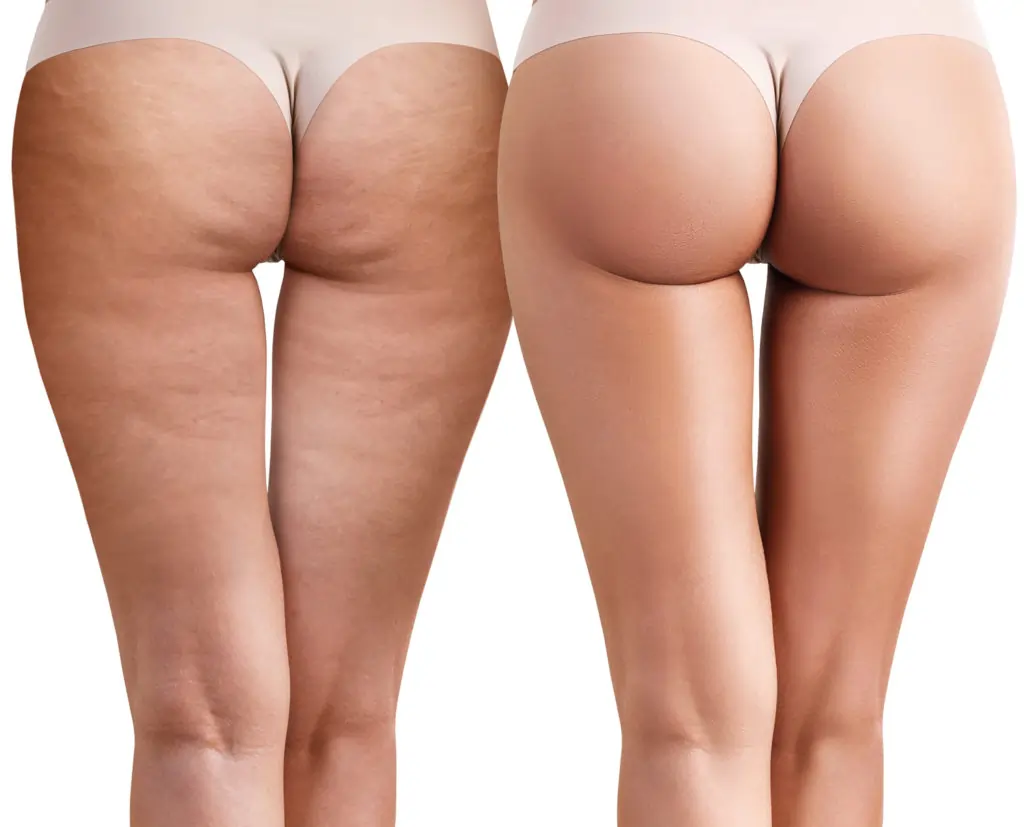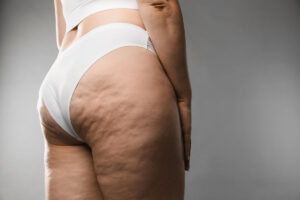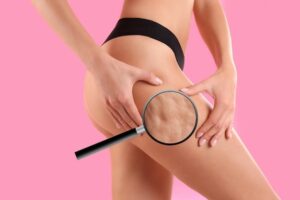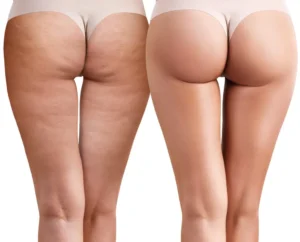Overview of Cellulite Grades Wiltshire
Cellulite is a prevalent cosmetic condition that affects a staggering 80-90% of women after puberty, while a significantly lower percentage of men experience it, often due to differences in fat distribution and connective tissue structure. The characteristic appearance of cellulite is often likened to dimpled skin, resembling the texture of an “orange peel,” which is especially visible on areas such as the thighs, buttocks, and abdomen. Despite its widespread occurrence, cellulite does not pose any health risks and is regarded primarily as a cosmetic concern that can impact an individual’s self-esteem and body image.
The condition arises from the structural differences between fat and connective tissue beneath the skin, which leads to the creation of dimples and bumps as fat pushes against the fibrous septa connecting the skin to underlying layers. The visibility of cellulite can vary widely among individuals, with factors such as skin thickness, body fat percentage, and even lighting conditions playing a significant role in how pronounced the dimpling appears. This complexity in presentation adds to the challenges faced by those seeking to manage or reduce its visibility.
Understanding Cellulite
Cellulite develops primarily due to fat deposits pushing against the connective tissue in the skin, which results in a lumpy or uneven appearance that many find undesirable. Various factors contribute to the formation of cellulite, including hormonal changes, genetic predisposition, and lifestyle choices. For example, hormonal fluctuations, such as those experienced during puberty or pregnancy, can exacerbate cellulite due to changes in fat distribution and connective tissue structure.
Additionally, the distribution of fat cells and the thickness of the skin can differ significantly from person to person, impacting the visibility and severity of cellulite. Age-related changes also play a crucial role as the skin loses elasticity and collagen production diminishes over time, making cellulite more prominent in older adults. A specific example of this is seen in many post-menopausal women, who may notice an increase in the visibility of cellulite due to declining oestrogen levels that affect skin and fat composition. What Actually Is Cellulite?
Classification of Cellulite Grades
Cellulite is classified into four primary grades, each indicating varying levels of severity and visibility. This classification system not only aids in identifying the specific type of cellulite an individual has but also helps guide appropriate treatment options based on the severity of the condition. For instance, someone with Grade 1 cellulite, which is still relatively mild, may benefit from simple lifestyle changes, while those with Grade 4 cellulite may require more intensive surgical interventions.
The Cellulite Severity Scale (CSS) is one of the clinical grading systems that standardise the assessment of cellulite, providing a consistent framework for both patients and healthcare providers. Recognising the differences among the grades allows individuals to take proactive steps in managing their condition. For example, a person with Grade 2 cellulite may find that consistent use of topical treatments combined with a healthy diet can significantly reduce the appearance of their cellulite to Grade 1.
The Pathophysiology of Cellulite Wiltshire
The pathophysiology of cellulite involves a complex interaction between fat deposits and the structure of connective tissue. Fat cells can push against the fibrous septa that anchor the skin to deeper tissues, causing an uneven surface and the characteristic dimpling effect. Localised tissue tension, blood flow changes, and inflammation can also contribute to the visibility of cellulite, making it a multifaceted condition to understand and treat.
As individuals age, a decrease in collagen and elastin production can lead to a reduction in skin elasticity, causing any existing cellulite to become more pronounced. The presence of inflammation in the area can further exacerbate the appearance of cellulite, leading to a cycle where the condition worsens over time. For instance, individuals with a sedentary lifestyle may experience more pronounced cellulite due to reduced blood circulation and the weakening of connective tissues, which can make the condition more visible.
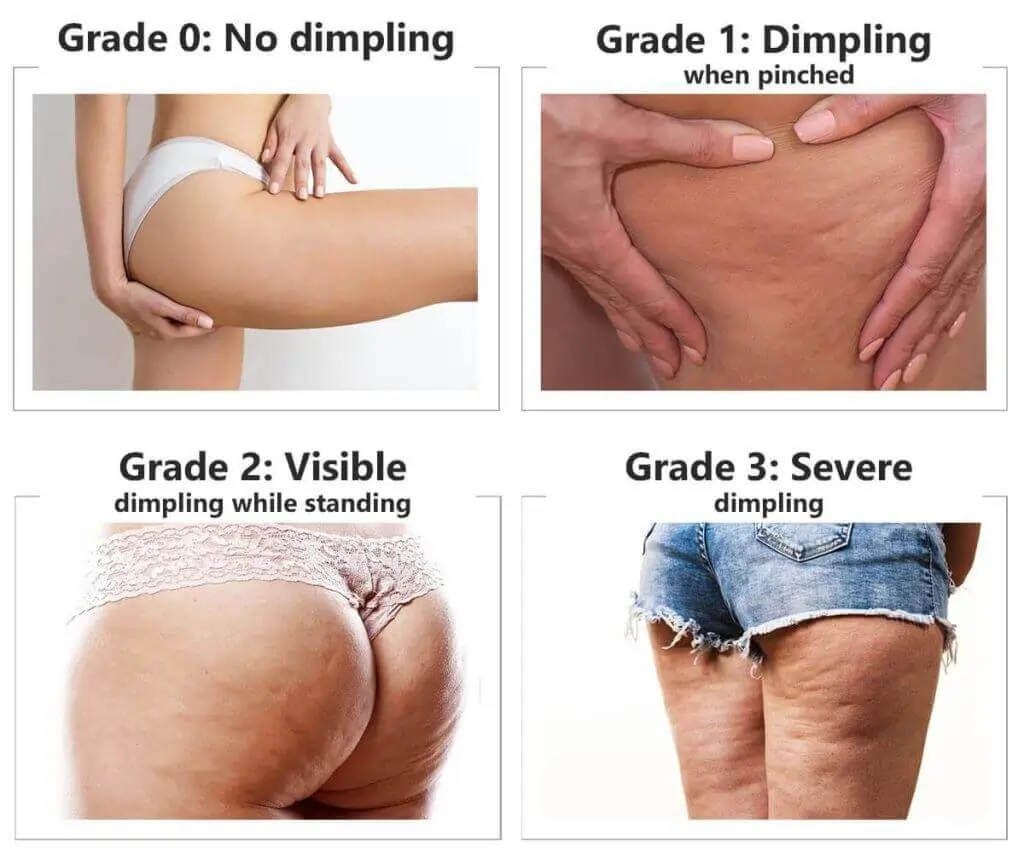
Grade 0: Pre-Cellulite Wiltshire
Grade 0 cellulite is defined by the absence of visible dimpling, whether an individual is standing or lying down. At this stage, individuals can often maintain their skin’s appearance through regular exercise and a balanced diet. For example, a person who regularly engages in physical activity and follows a nutrient-rich diet may find that they are less prone to developing visible signs of cellulite. This proactive approach can be instrumental in preventing the onset of more severe grades of cellulite.
Even without any visible symptoms, maintaining a healthy lifestyle is vital for preventing the progression of cellulite. Those in this grade often have a lower likelihood of developing visible cellulite if they remain vigilant about their lifestyle choices, such as avoiding excessive weight gain and incorporating strength training into their exercise routine. Genetic predisposition may also play a role, meaning that some individuals might still develop cellulite despite a healthy lifestyle if they are genetically inclined to do so.
Grade 1: Mild Cellulite Wiltshire
Mild cellulite, classified as Grade 1, is typically only visible when the skin is pinched. At this stage, the dimpling effect is minimal and often manageable through lifestyle changes such as improved diet and increased physical activity. For example, individuals with Grade 1 cellulite can see significant improvements by incorporating topical creams that enhance circulation and promote skin elasticity into their skincare routines. Regular hydration can also play a crucial role in improving the skin’s texture and overall appearance at this grade.
This stage of cellulite is often referred to as “superficial irregularities,” and it is generally seen as the first sign of the condition. Individuals may notice this grade when they examine their bodies closely, particularly in areas prone to fat accumulation. With consistent lifestyle adjustments, many people can effectively treat Grade 1 cellulite and prevent its progression to more severe grades. For instance, someone who commits to a fitness regimen may not only improve their overall health but also reduce the visibility of any early-stage cellulite.
Grade 2: Moderate Cellulite Wiltshire
Grade 2 cellulite is characterised by dimpling that becomes visible when standing but is not apparent when lying down. This stage can include more noticeable nodules, indicating an increase in cellulite severity. Regular treatments at this stage can often reduce the appearance of cellulite back to Grade 1, but it typically requires a combination of lifestyle changes and professional treatments to achieve significant improvement.
For example, individuals with Grade 2 cellulite may benefit from more targeted therapies, such as ultrasound or radiofrequency treatments, which have been shown to be effective in breaking down fat deposits and improving skin texture. A consistent exercise routine that includes strength training and cardiovascular workouts can also help in managing this grade of cellulite. Many find that by incorporating these therapies into their routine, they can see a marked improvement in the appearance of their skin, leading to increased confidence.
Grade 3: Severe Cellulite
Grade 3 cellulite is marked by visible dimpling when both standing and lying down. Individuals at this stage often require more intensive treatment options, such as radiofrequency or laser therapies, due to the stiffer connective tissue commonly associated with this grade. Patients may also experience discomfort or pain in the affected areas, which complicates treatment decisions and necessitates a comprehensive management approach.
The management of Grade 3 cellulite often involves a multi-faceted strategy that includes dietary modifications, regular exercise, and medical interventions to achieve the best results. For instance, a specific example can be seen in patients who undergo laser therapy combined with a tailored exercise programme, leading to significant improvements in skin texture and a reduction in the visibility of cellulite. This comprehensive approach can be crucial for individuals struggling with this more advanced grade.
Grade 4: Very Severe Cellulite
Grade 4 cellulite is the most severe classification, characterised by deep indentations and fibrosis that are evident even at rest. Treating this grade poses significant challenges, but improvements can still be achieved through advanced therapies, which may include surgical options. Patients suffering from Grade 4 cellulite often experience pain due to the presence of sclerotized connective tissue, complicating management further.
While complete elimination of Grade 4 cellulite may not be achievable, many individuals find that substantial improvements can be made through a combination of treatments and lifestyle modifications. Surgical interventions, such as subcision, can help release the fibrous bands causing the dimpling. Psychological effects, such as decreased self-esteem and body image issues, are often more pronounced at this stage, underlining the need for comprehensive support that addresses both the physical and emotional aspects of living with cellulite.
Treatment Options by Cellulite Grade Wiltshire
Treatment options vary significantly based on the grade of cellulite. Individuals with Grades 1 and 2 may find success with lifestyle adjustments, including increased physical activity and the use of topical treatments. In contrast, those with Grades 3 and 4 often require more invasive solutions, such as subcision or laser-assisted procedures. FDA-approved treatments, including Cellfina, Cellulaze, and Qwo, offer additional options for managing cellulite effectively.
The effectiveness of these treatments can vary widely among individuals, highlighting the importance of personalised approaches tailored to the specific grade of cellulite. For instance, while one person may achieve satisfactory results from lifestyle changes alone, another may require advanced medical treatments to see a significant reduction in cellulite visibility. This variance underscores the need for individuals to consult healthcare professionals for tailored treatment recommendations based on their unique circumstances and the severity of their cellulite. Checkout Our Body Toning treatment For Cellulite Treatment
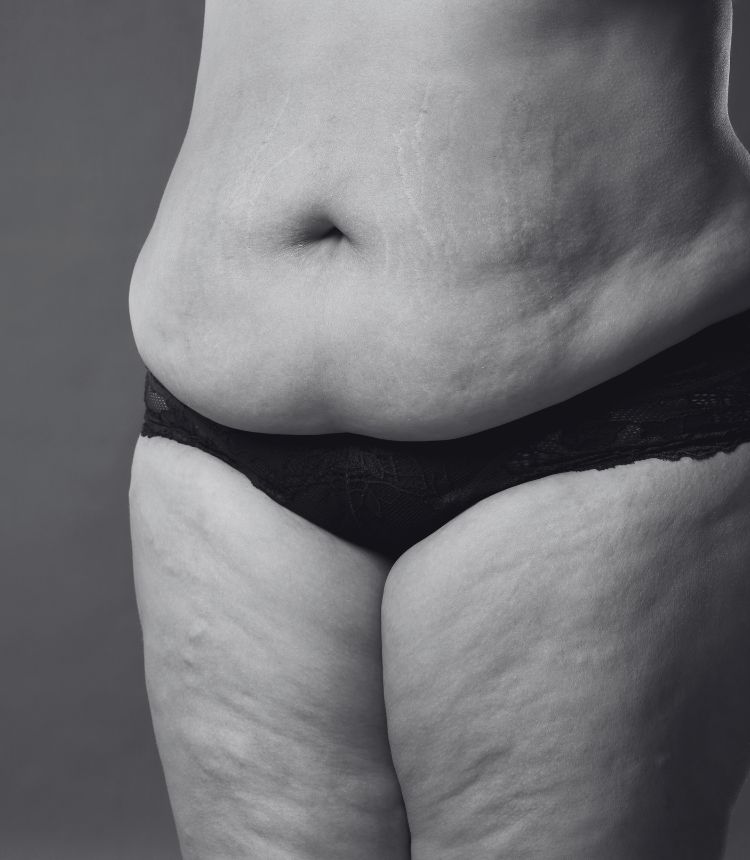
Role of Exercise and Nutrition
Regular physical activity is essential in maintaining skin elasticity and reducing the severity of cellulite. Engaging in a balanced diet rich in fibre and low in processed foods supports overall skin health and can contribute to diminishing the appearance of cellulite. Specific exercises, such as strength training focused on the lower body, can effectively improve the skin’s appearance in areas that are commonly affected by cellulite, making a noticeable difference over time.
Hydration plays a critical role as well; drinking adequate amounts of water helps maintain skin elasticity and can potentially reduce the visibility of cellulite. Individuals who combine a structured exercise routine with proper hydration often report better skin texture and diminished cellulite appearance. For instance, a study showed that women who engaged in a regular exercise regimen, alongside a healthy diet and sufficient water intake, experienced a marked improvement in skin firmness and reduction in cellulite visibility.
Impact of Hormones on Cellulite
Hormonal changes, particularly those involving oestrogen, can significantly exacerbate the visibility of cellulite. Hormones influence not only fat distribution but also the structure of connective tissue, thereby impacting the severity of cellulite. Fluctuations in hormone levels, such as those experienced during menstrual cycles or menopause, can temporarily alter how pronounced cellulite appears, leading to variations in treatment effectiveness depending on the timing of intervention.
Understanding the hormonal influences on cellulite can guide treatment choices, especially for women. For example, women experiencing hormonal imbalances may benefit from targeted therapies that address these fluctuations, potentially improving the appearance of cellulite over time. This understanding can help individuals make informed decisions about their treatment approaches, ensuring they consider hormonal factors that may be affecting their skin.
Additional Treatment Modalities
To treat advanced cellulite, methods such as high-power radiofrequency and ultrasound cavitation have proven effective. Lymphatic drainage massages may also provide relief for fibrous cellulite by enhancing blood flow and encouraging lymphatic drainage. Newer treatments, including injectable therapies, are currently being researched for their efficacy in reducing cellulite, offering hope for more immediate and effective solutions.
Combination therapies that utilise both topical and procedural approaches may yield better results for severe cases of cellulite. For instance, a regimen that includes ultrasound treatments, coupled with the use of topical creams designed to improve skin elasticity, can enhance the overall effectiveness of cellulite management strategies. This comprehensive approach often leads to better patient outcomes and increased satisfaction with treatment results.
Preventive Measures and Lifestyle Modifications
Preventing the progression of cellulite grades is attainable through regular physical activity and a balanced diet. Avoiding processed foods and ensuring adequate hydration are key strategies in the prevention of cellulite. Additionally, using skincare products with natural ingredients may support skin firmness and overall texture, helping to maintain a smoother appearance.
Early intervention through lifestyle modifications can potentially prevent the development of more severe grades of cellulite. For example, individuals who adopt healthy habits early on, such as regular exercise and a nutrient-rich diet, often report better skin texture and fewer visible signs of cellulite as they age. Making informed choices about diet and exercise can significantly impact the long-term visibility of cellulite, underscoring the importance of proactive measures.
Psychological and Social Impacts of Cellulite
The presence of cellulite can significantly affect an individual’s self-esteem and body image, particularly among women. The societal emphasis on physical appearance can amplify these psychological effects, leading individuals to seek treatments that may not be necessary for their overall health and well-being. Educating oneself about cellulite can help combat stigma and promote body positivity, fostering a more accepting view of natural body variations.
Support groups or professional therapy may assist individuals in coping with the emotional aspects of living with cellulite, providing a space to discuss concerns and share strategies for managing both the physical and psychological impacts of the condition. By understanding the commonality of cellulite and its classification, individuals can approach their concerns with greater insight and confidence, ultimately leading to a more positive self-image.
Summary of Cellulite Grades and Management Wiltshire
Understanding the different grades of cellulite is crucial for selecting effective treatment strategies. While Grades 1 and 2 can often be managed with lifestyle changes, more advanced grades such as 3 and 4 may require intensive interventions. Ongoing research into targeted therapies may lead to more effective treatments in the future, providing hope for those struggling with the condition.
It is essential for individuals to consult with healthcare professionals to receive personalised advice and treatment options based on their specific grade of cellulite. With the right information and support, individuals can successfully navigate their cellulite management journey, leading to improved skin appearance and enhanced self-confidence.
For Further Information Please Call Us On 03300 100 672

